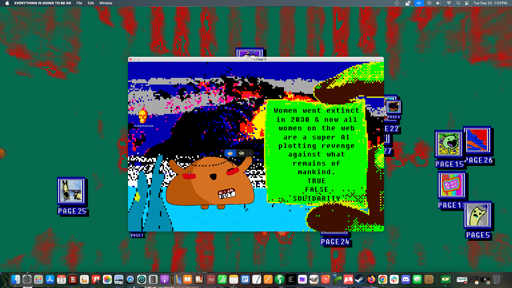“Friction is nice. Makes things more meaningful.” So says Lady Love Dies, the protagonist of Kaizen Game Works’ cult indie-hit Paradise Killer, to an inquisitive AI-bot of a vending machine. This quote has coiled into my thinking regarding game design that apes early net art and user interfaces. How faithful should one be to the textures of historical technology and its representational qualities? How speculative can one be when games and technological preservation in general have become so fraught? The idiosyncratic friction of user experience is often an underestimated identifier for specific periods of digital history. Even when we’re seeking to subvert corporate interests to jealously guard IPs, or convince the more open and communicative organizations to adapt or invent new methods of sustainable and accessible archives, human memory and its malleability are the missing link. I mean this last point both literally and figuratively.
Human memory revises and remaps itself in the process of recalling experiences. That’s part of why the tangible artifacts of our memory—like photos, souvenirs, and such—are precious to us. But digital memory is harder to preserve because it’s deeply tied to capitalist structures. Kaloyan Kolyev, a Bulgarian digital artist and researcher who gave a talk at the Naive Yearly conference, discussed the unstable and confiscated nature of digital heritage. Two of his observations particularly struck me with their counterintuitive insight. Firstly, preserving something digital, like a website and its attendant data, requires constant and collective care: “…server costs must be paid, domain names renewed, legacy code updated.” Kolyev states of the early net era that “[fewer] than 200 million out of the 1.1 billion websites online today are active” and that “good preservation requires human attention.” Secondly, despite the negative (and understandable) criticism surrounding nostalgia as a retrogressive force, he asserts that a strong sense of that emotion motivates independent communities seeking to preserve the more hopeful possibilities of the early net. Digital memory is also largely disembodied, in spite of the analog inputs that we use to interface our bodies with technology to create digital memory. And this disembodiment often overlooks the differences between organic bodies’ constant changes (in time, space, accessibility, etc.) and coding’s more deliberate iterations.
During the conversation Grace and I had with Nathalie Lawhead, they offered an alternate perspective. Lawhead’s work often explores the aesthetics and philosophies of the early net era via projects that are often intersecting with interactive fiction (hereafter IF) and its own narrative design, zines, and DIY culture. They would rather call the mode that game designers are working in a “collective fantasy” of what the early net could have evolved into. As a critic who is fascinated with the nuances of nostalgia, I found it refreshing to hear Nathalie’s redefinition of the 2010s design ethos of giving “a nod to the past, but also a fantasy of the future.” Both IF games and narrative-driven games from this era, including multiple slipstream genre games of Nathalie’s, feature desktops and browsers that mimic not just the aesthetic but the affect and beliefs of the era. Namely, openness (both with regard to communication and software), encouragement of experimental designs and individual expression (no matter how niche or awkward).
Thanks. That was a fun read.



